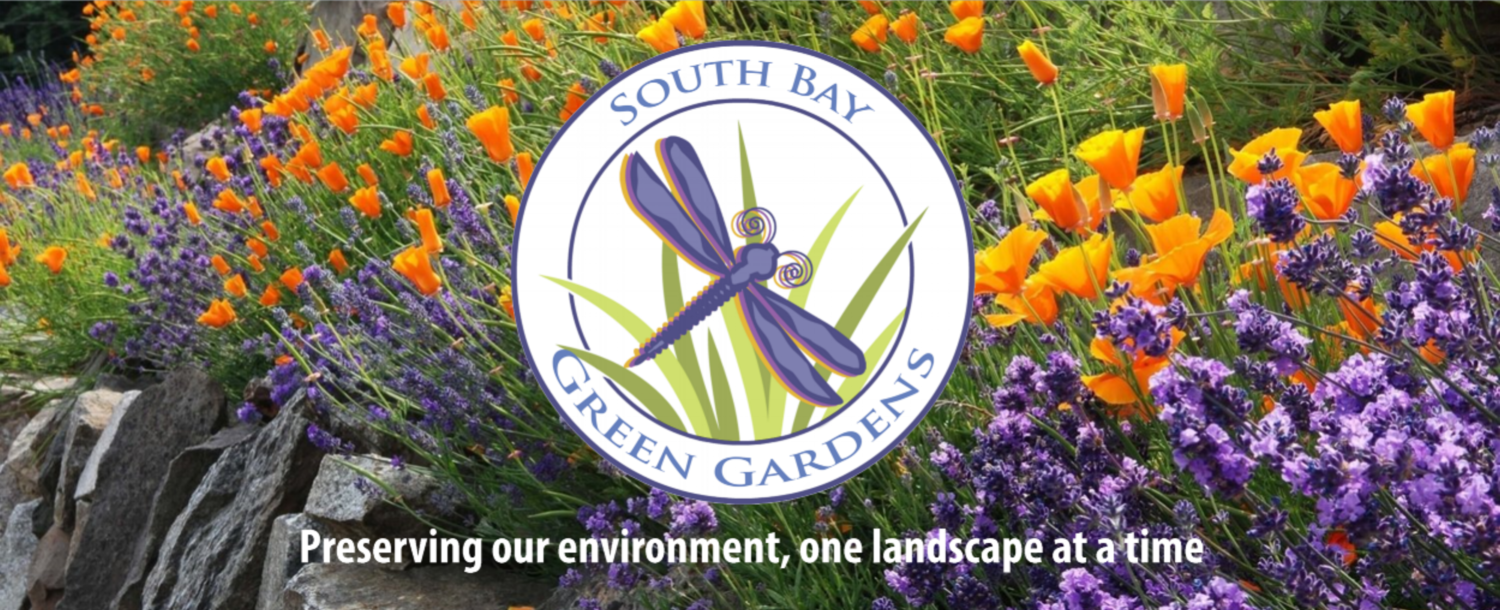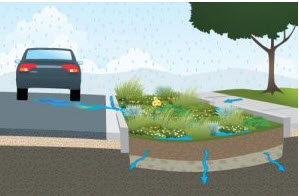Rainwater Management:
Green Infrastructure
In natural landscapes, rain that falls on the ground mostly soaks, or infiltrates, into the soil. However, in urban areas, impervious surfaces such as roofs, pavement, and streets, prevent infiltration. As rain and excess irrigation water flow over these paved surfaces, they can pick up pollutants and carry them into local storm drains, local creeks, and the Bay.
Cities and towns in Santa Clara Valley are working together to create sustainable or green streets, buildings, and parking lots that mimic natural landscapes, by incorporating green infrastructure. These features allow rainwater flowing over buildings, streets, and parking lots to soak into the ground and be filtered by soil. This reduces the quantity of water and pollutants flowing into storm drains and local creeks.
This page provides videos, technical guidance, and other resources to help implement green infrastructure projects for rainwater harvesting (rain barrels, cisterns, rain gardens, and more) and stormwater management (bioretention areas, bioswales, green roofs, permeable pavement, among other options).
NEW: Santa Clara Valley Water District’s Rainwater Capture Rebates!! Through our Landscape Rebate Program online application process, residents and business owners can apply to:
Receive a rebate up to $35 per qualifying rain barrel installed to collect rainwater from existing downspouts
Receive a rebate of $0.50 per gallon for diverting existing downspouts to qualifying cisterns
Receive a rebate of $1 per square foot of roof area diverted (up to $300 per site) into an installed rain garden to collect roof water runoff
Projects that have been started or projects that have already been completed prior to application approval are not eligible. Learn more about Rainwater Capture Rebates.
At the scale of a city or county, green infrastructure refers to the patchwork of natural areas that provide habitat, flood protection, cleaner air, and cleaner water.
Projects may include wetland preservation, protection of open spaces, and curb cuts to help redirect rainwater from the street into landscapes.
At the scale of a neighborhood or project site, green infrastructure refers to stormwater management systems that mimic nature by soaking up and storing water.
Projects may include permeable parking lots and green roofs.
At the residential scale, rain gardens that treat and temporarily retain runoff from downspouts and driveways are the most applicable and accessible type of green infrastructure to install yourself.
Projects may include rain barrels and rain gardens.
Green infrastructure provides many benefits to the community. In addition to improving water quality, green infrastructure is also viewed as an outlet to create or enhance recreational and public use areas by creating attractive streetscapes and habitat, reducing the heat island effect, and increasing accessibility for multiple modes of transportation.
Click here for examples throughout Santa Clara County to inspire your own projects!
For an overview of these exciting opportunities to conserve water while creating healthier ecosystems within our communities, click here. Or click here for a more technical yet accessible overview.
Sustainable Landscapes vs. Conventional Landscapes - What's the difference?
Conventional landscapes tend to feature plants that need lots of water or may need frequent use of gasoline-powered equipment to manage them properly. Also, conventional landscapes often rely on pesticides and fertilizers to promote healthy growth. Rain or excess irrigation water can transport these pollutants down street gutters and into storm drains, which empty directly into the nearest creek and the San Francisco Bay. Such pollution is harmful to fish, wildlife, and human health.
Comprehensive list of creek-friendly improvements to your yard.
Capture Rainwater
Your yard can actually retain and clean rainwater. Capturing and storing rainwater reduces the need for irrigation with precious drinking water. Using permeable pavement, rain gardens, swales, or dry creek beds, you’ll help reduce peak runoff during rain events, allowing the soil to soak up rainfall and give soil microbes a chance to filter some of the pollutants. These features may also add a unique, creative look to your landscape. Or, with proper permitting, rainwater can be captured and used indoors for flushing toilets or even washing your clothes.
Please note: SAVE WATER, NOT MOSQUITOES!
Did you know that one of the most common problems with rain barrels is mosquito breeding? Thousands of mosquitoes can emerge from standing water inside a rain barrel. Follow these three simple steps to eliminate mosquitoes:
1. Cover the barrel and all openings
2. Empty barrels on a regular basis
3. Keep the lid clear of standing water
Do your part to prevent West Nile and Zika virus outbreaks!
HOW TO INSTALL A PROJECT
Rain barrel and cisterns for smaller projects.
For general Rainwater Harvesting info, please click here.
Raingardens and Bioretention areas
Tips for Installing dry creek beds and bioswales
Direct Stormwater to your Landscape: Designs & Techniques
Pervious Pavement Material Guide
For more information on green roofs, rain gardens, infiltration trenches, pervious surfaces, creek-friendly improvements, and other stormwater improvements, click here.
Watershed Watch Campaign to Protect our Creeks and Bay
How to Videos:
Overview of making a raingarden (Sustainable World Media)
Overview and benefits of rain barrels, raingardens and bioswales (CA Water Board)
How to build a rain barrel, rainwater collection system, and practical rain garden tips (California Water Efficiency Partnership)
How to build a raingarden or bioswale (California Water Efficiency Partnership)
Breaking Up is Easy to Do - Permeable Hardscape Overview from the CA Water Board.
For developers, builders, and project applicants to meet local municipal requirements for stormwater management projects:
Stormwater Management Project Guidelines (County of Santa Clara Planning and Development Department)
C3 Stormwater Handbook, Guidance for Implementing Stormwater Requirements for New Development and Redevelopment Projects: Technical guidance for San Francisco Bay Watershed (North County)
§ Chapter 6: Stormwater Treatment and Design Measures
§ Appendix D: Plant List and Planting Guidance
Stormwater Management Guidance Manual for Low Impact Development & Post-Construction Requirements: Technical guidance for South County
Fact sheets, Green Building information, and other resources from the City of Palo Alto
Still have questions? Check out the UC Master Gardener’s rain garden blog for additional overviews, resources, and guidance.
RESOURCES FOR GOVERNMENT OFFICIALS & PLANNERS
The following resources developed by the Environmental Protection Agency (EPA) is geared toward municipalities to assist implementation and evaluation of rainwater harvesting, stormwater management, and other green infrastructure.
Enhancing Sustainable Communities with Green Infrastructure to help communities better manage stormwater while achieving other environmental, public health, social, and economic benefits.
Green Infrastructure Opportunities that Arise During Municipal Operations Municipal Opportunities in Public Spaces for Small and Mid-Size Communities
Tools, Strategies and Lessons Learned from EPA Green Infrastructure Technical Assistance Projects to provide practical, successful solutions to inspire city managers, community leaders and engaged citizens looking to design their community space for better health, abundant water resources, and improved quality of life.
Water Quality Scorecard [PDF] was developed to help local governments identify opportunities to remove barriers, and to revise or create codes, ordinances, and incentives for better water quality protection.
OTHER AGENCY GUIDES
Please see the Santa Clara County resources above. The guides below should be for reference only:
Slow it. Spread it. Sink it. (Resource Conservation District of Santa Cruz County) and Sonoma County
Rainwater Harvesting Manual (San Francisco Public Utilities Commission)
Stormwater Management Requirements and Design Guidelines (San Francisco Public Utilities Commission)
California Stormwater Quality Association Resources. This Technical Assistance Memo provides plant selection guidance for the most common bioretention features, such as bioretention swales and stormwater planters: Low Impact Development for Plant Guidance for Bioretention.
Central Coast Low Impact Development Initiative - a variety of resources, located here.






